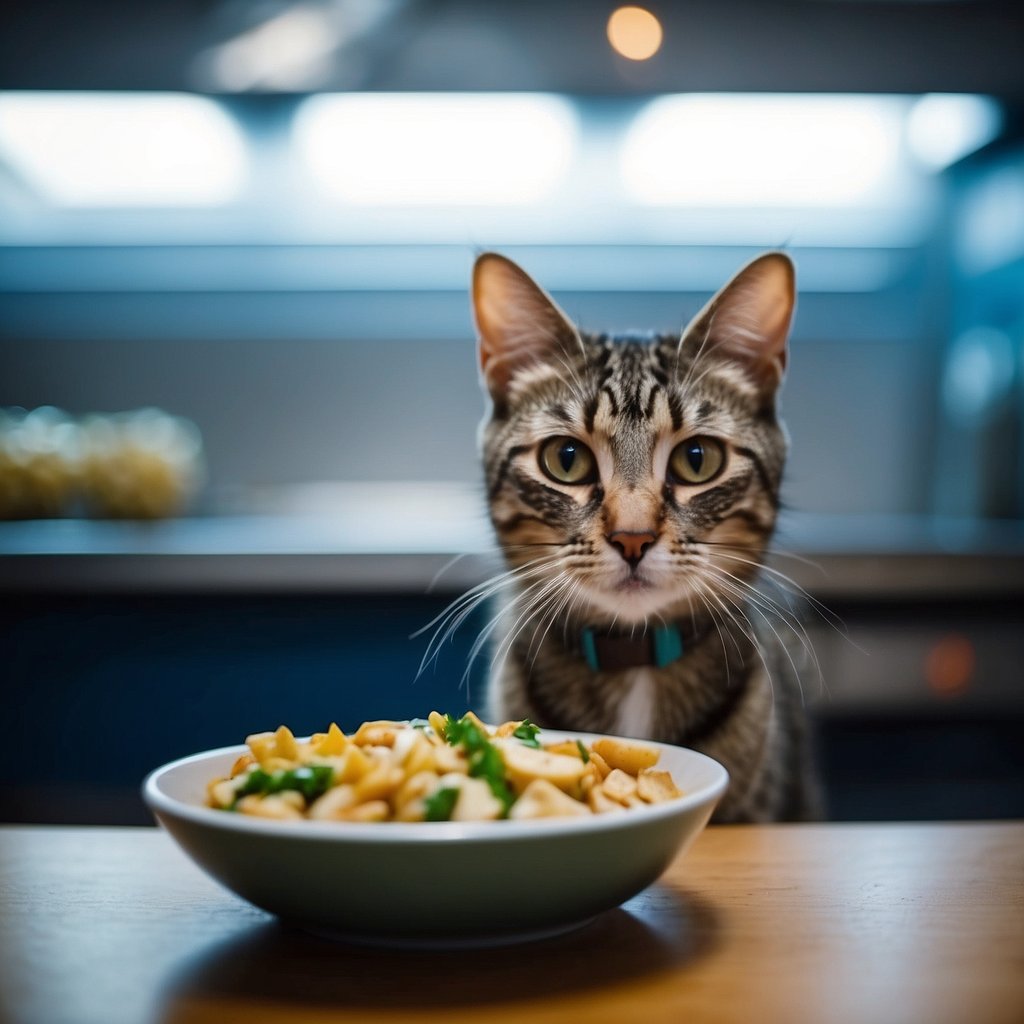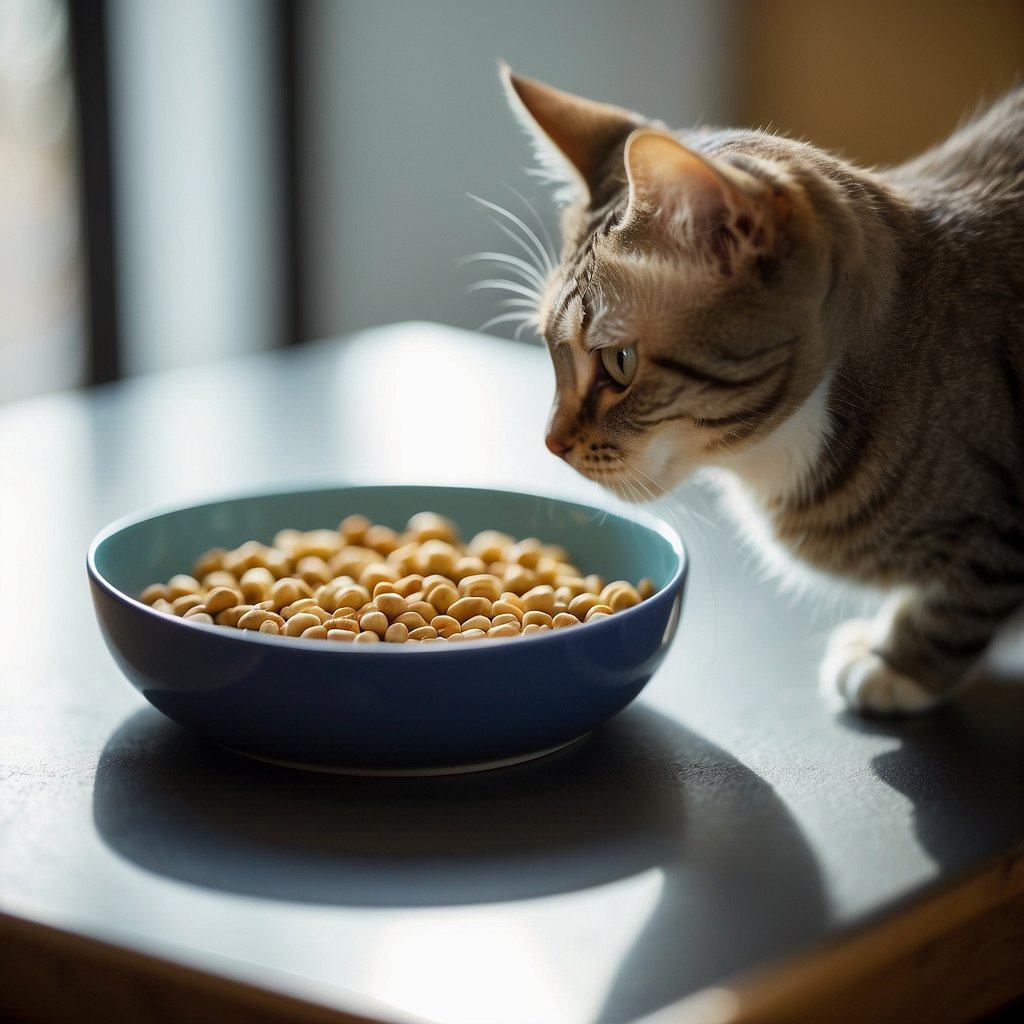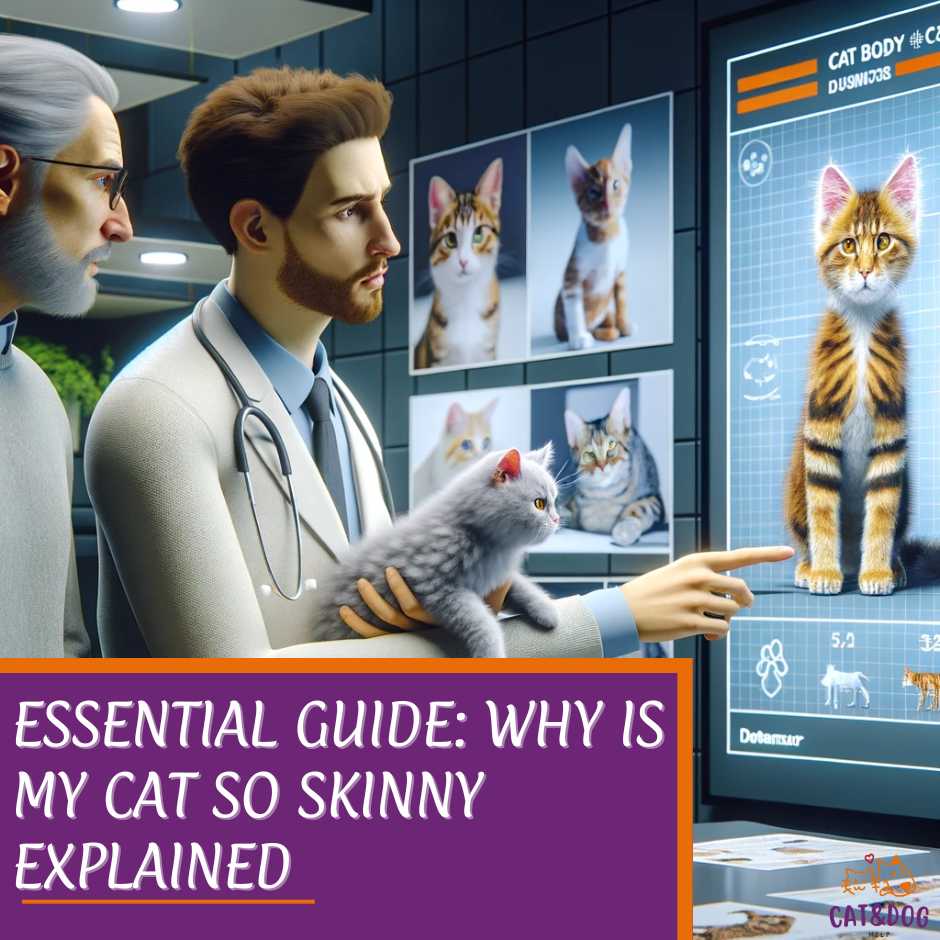Noticing your cat’s sleek figure might initially seem like a sign of feline fitness, but what if your furry friend is a bit too slim?
It’s not uncommon for cat owners to suddenly realize their pet’s ribs are more prominent than before, prompting concern.
Cats can be rather mysterious with their habits, and weight is one area where they might be hiding something.
Maybe you’ve noticed less interest in food, or perhaps she’s still gobbling up dinner but not keeping on the pounds.
No need to fret just yet, though; we’ve got the scoop on how to figure out what’s going on with your slender companion.

Why is my cat so skinny?
Weight loss in cats can be subtle and gradual, and it’s wise to learn how to assess your cat’s body condition properly, including their cat’s weight.
A healthy cat should have a small amount of fat over their ribs, which should not be sharply visible. (1)
If you’re sensing too much bone and not enough padding during petting sessions, it could be a sign that your cat is under her target weight or kitten’s weight.
From dietary needs to potential health issues, numerous factors can tip the scales. But don’t worry, because identifying the problem is the first step to getting your cat back to a normal weight.
By comparing the feel of your cat’s ribs to the back of your hand, where your metacarpals are, you can determine if they have the right amount of padding over their knuckles. (2)
Understanding why your cat might be shedding pounds is crucial for their well-being.
While age can certainly play a role, with older cats being prone to weight loss due to decreased appetite or absorption issues, other culprits could include dental pain or dental disease, competition at the food bowl, or mental health issues.
Each skinny cat is a unique case, so it’s essential to tailor your care strategy to their specific needs.
If your skinny kitty is giving you pause, it’s a good idea to get to the veterinarian to help identify potential issues sooner rather than later, especially if they may be diabetic cats.
Stay tuned; we’ll help guide you through these steps to ensure your cat maintains a healthy weight and consumes enough calories.
Key Takeaways
- Evaluating your cat’s weight is crucial for their health.
- Numerous factors can contribute to a cat losing weight.
- Tailored strategies can help your cat reach a healthy weight.
Understanding Cat Weight Loss
Are you noticing your furry friend looking a bit on the thin side? Let’s unravel the mystery behind why your cat might be losing weight.
Sometimes it’s like playing detective with a particularly fluffy culprit, but don’t worry, we’ll get to the bottom of it together.
Common Causes of Weight Loss in Cats You know better than anyone when your cat isn’t quite themselves. Could there be a sneaky medical condition at play? (3)
Conditions like hyperthyroidism, which affects up to 10% of felines over 10 years old, can rev up their metabolism, leading to weight loss. It’s like they’ve hit the kitty gym too hard!
Keep an eye out for symptoms like a ravenous appetite or restlessness to determine if a serious illness, such as cancer or food allergies, might be at the root of the problem, including obesity, vomiting, and lack of appetite.
Or is your cat’s inner sugar fiend out? Diabetes might be to blame and, trust me, cats get it too. It’s not all about their sweet disposition, sadly. Watch for increased thirst and more frequent trips to the litter box.
Exploring Dietary Factors Maybe your cat is being a picky eater—or could it be something more? Poor digestion and malnutrition aren’t as obvious but just as crucial.
According to nutrition studies, cats need a balance of proteins, fats, and carbohydrates. If they’re turning up their nose at their dinner, they might not be getting enough food, whether it’s wet food or dry food. (4)
Adding a little water from a tin of tuna (not brine) to their food can also help encourage them to eat more. It is important to ensure your cat receives enough nutrition from their food, including tuna, to meet its nutritional needs.
Make sure your cat receives full nutrition food and grain free..
Age-Related Changes Ever heard the term ‘senior slenderness’? As cats grow older, their metabolism changes, and so does their ability to wolf down food. Less munching naturally leads to weight loss.
When to Be Concerned About Your Cat’s Weight So, when should you start worrying? If your cat shows these signs, it’s time for a vet visit:
- Lethargy: More snooze time than playtime?
- Coat changes: Has their coat lost its luster?
- Appetite changes: Ignoring their once-beloved meals?
These clues point to something more serious. Remember, staying informed is your superpower, and it could be a game-changer for your cat’s health. Keep those detective eyes open!
Assessing Your Cat’s Body Condition
Wondering if your cat is too skinny? You’ve got two reliable methods to figure that out: the informal hand test and the Body Condition Scoring system. Let’s get hands-on and talk you through these approaches!
The Informal Hand Test Method Curious to see how your furry friend measures up? Try the hand test:
- Palpate the Ribs: Gently run your hands along your cat’s sides. Can you feel the ribs? They should be distinguishable but not protrude sharply.
- Check the Waist: Observe your cat from above. Is there a slight inward curve behind the ribs? That’s your cat’s waist, and it should be visible without being extreme. (5)
- Side View: Looking from the side, there should be a graceful upward tuck of the abdomen; no sagging belly here.
Using the Body Condition Scoring System Now, let’s score your cat like a pro:
- Score 1-3 (Thin to Underweight):
- 1: Severely emaciated, all bones visible from a distance.
- 2: Underweight, ribs easily felt with minimal fat covering.
- 3: Slightly underweight, ribs felt with slight fat covering.
- Score 4-5 (Ideal Weight)
- 4: Good shape, a noticeable waist, and abdominal tuck.
- 5: Perfect score, well-proportioned, ribs felt with slight fat cover, you can see the waist.
- Score 6-9 (Overweight to Obese):
- 6: Overweight, ribs hard to feel under a fat layer, waist barely visible.
- 7: Heavy, waist and abdominal tuck not apparent, fat deposits noticeable.
- 9: Severely obese, no waist or abdominal tuck, large fat deposits around the abdomen, spine, and base of the tail.
Remember, while this is helpful, nothing beats a vet’s expertise. If you’re unsure about your findings, schedule a check-up.
Keeping your cat healthy means knowing their body as well as you know how to land a joke about their ninth life!
Steps to Take for a Skinny Cat
Dietary Adjustments:
- High-Quality Diet: Ensure you’re feeding them high-protein cat food; cats are carnivores after all!
- Portion Size: Check if the portion sizes match your cat’s age, size, and activity level. Sometimes, just a bit more can do the trick.
- Frequent Meals: Smaller, more frequent meals can aid digestion and increase calorie intake.
- Hydration: Always have fresh water available to promote hydration and digestive health.
If you’re unsure what’s best for your kitty, a chat with a dietitian or nutritionist could shed some light on a meal plan tailored to your cat’s needs. (6)
Importance of Veterinary Consultation:
- Health Screening: Schedule a visit to the vet. A skinny cat may have underlying health issues. Diagnostic tests can uncover problems ranging from parasites to chronic diseases.
- Diagnostic Statistics: Did you know that gastrointestinal disorders are common in skinny cats? Stay informed by seeking professional advice.
Begin a Health Journal
| Date | Weight | Food Intake | Behavior Notes | Vet Appointments |
| 01/20/24 | 5 lbs | 1 cup | Playful | Scheduled |
| 01/27/24 | 5.1 lbs | 1.2 cups | Lethargic | Completed |
This table keeps track of progress and can be invaluable during vet visits.
So, get started with these steps and you will be on the pathway to feline health. With good food served to cat and a bit of detective work, your skinny cat can become a healthy , happy ball of fluff.
Keep an eye on their weight and behavior, and never hesitate to seek expert advice when in doubt. After all, they’re part of the family!
If you found this content useful, all our blog content on Toe Beans is social media shareable. So, what are you waiting for to spread the love ??
Go ahead and hit any social media icon of your preference around the post for instant sharing with friends and family. Sharing is caring!
Personalized Cat Care Strategies
Monitoring Your Cat’s Diet
Isn’t it puzzling when your cat seems to eat well but remains skinny? Your furry friend may require a diet tailored to its specific needs. Here’s what you can do:
- Balanced Meals: Serve a balanced diet rich in protein, fats, and essential vitamins. Always consult your vet on the best nutrition plan.
- Portion Control: Observe how much your feline eats. Underfeeding could be the culprit; adjust portions accordingly, but avoid overfeeding. (7)
Regular Vet Checkups
Remember, it’s not just about what they eat, but also their overall health.
- Health Screening: Book regular vet visits to rule out underlying health conditions, as these often contribute to weight loss.
- Dental Health: Check those pearly whites! Dental issues in cat can deter your cat from eating properly.
Understanding Age-related Changes
Did you know older cats can lose weight due to decreased nutrient absorption? Keep an eye on:
- Metabolic Changes: Senior cats need diets catered to their slowing metabolism.
- Appetite Fluctuations: A drop in sense of smell or dental loss could reduce their eagerness to eat.
Case in Point
Take Leo, a tabby cat who was too skinny despite a full bowl. A switch to a vet-recommended, high-calorie diet turned things around. Leo gained a healthy weight and was soon thriving.
Last but not least, always take a proactive approach:
- Body Condition Scoring: Learn this technique to regularly assess your cat’s body condition. A skinny waist or visible ribs call for a diet adjustment.
- Observation: Watch for changes in behavior. Are they eating less? Do they seem less active? Time to act!
Mixing up care with fun can make a huge impact on your cat’s health. With these strategies, you’ll have your cat in tip-top shape, and you’ll feel like a super pet parent!
Maintaining Healthy Weight in Cats
Balanced Diet and Nutrition
What’s on your cat’s menu? It should be a balance of:
- Protein: It’s a cat’s main event! Aim for high-quality protein sources.
- Fats: Essential for energy but keep it in check.
- Vitamins and Minerals: To support all their nine lives!
Serve meals in portion sizes appropriate to your cat’s age, activity level, and health status—no one-size-fits-all here. And remember, fresh water should always be available; it’s a non-negotiable!
Regular Health Check-ups
Just like you, your cat needs those regular check-ins. You’d catch up with a buddy, so why not book a wellness exam for your whiskered compadre?
Yearly visits are your vet’s chance to ensure your cat’s weight is on the right track.
Monitoring Changes in Eating Habits
- Noticing more leftovers in the bowl?
- Is your feline friend acting finicky?
These could be little red flags waving at you to pay attention. Swift changes in eating habits might need a professional’s eye.
Your vet can provide the best course of action, whether it’s a change in diet or further investigation.
By keeping tabs on these aspects, you’ll be well on your way to ensuring your cat maintains a healthy weight.ubbo
Quick Recap on Why Is My Cat So Skinny

Let’s get down to the key reasons your cat might be skinnier:
- Advanced Age: As cats get older, their digestive systems may not work as efficiently, leading to weight loss.
- Dietary Needs: Cats thrive on a diet rich in proteins, fats, and vitamins. If their diet lacks these, they might lose weight.
- Health Issues: Various medical conditions can cause weight loss, so it’s important to consult a vet.
Here’s a tabular rundown of potentially underlying health concerns:
| Potential Issue | Why It’s a Problem |
| Age-related Changes | Absorption issues leading to muscle loss |
| Inadequate Nutrition | Lack of essential nutrients affecting weight |
| Medical Conditions | Health issues that could lead to weight loss |
It’s essential to keep an eye on your cat’s health and weight. If your furry friend isn’t quite the chonker they once were, then a vet visit might be in order.
And while some may view a slim cat as healthy, it’s all about balance – not too heavy, not too light. Adult cats should get two meals daily spaced eight to 12 hours apart.
Remember, proactive health monitoring is key! Keep those routine check-ups in the diary and ensure your cat’s diet is up to scratch for their lifestyle.
Your vigilance could be the ticket to ensuring your kitty’s long-term well-being. Time for a weigh-in?
Frequently Asked Questions
Navigating your cat’s health can be puzzling, especially when they appear to eat well but remain skinny. Here are some specifics that might shed light on this peculiar situation.
What could be the cause if my cat seems to be eating enough yet remains very thin?
Your cat’s high metabolism or dietary issues might not be the only factors at play.
Despite a good appetite, certain medical conditions, such as hyperthyroidism or parasites, can prevent weight gain.
How can I determine if my cat is underweight and what are the implications of feeling their bones through their coat?
If you can easily feel your cat’s ribs, hip bones, or spine, they may be underweight.
This can hide under a fluffy coat but is a sign that your cat might not be getting enough nutrients or may have health issues requiring a vet’s assessment.
Is it normal for older cats to become skinnier?
Yes, it’s common for senior cats to lose weight due to factors like a decrease in their ability to digest and absorb nutrients, dental issues, or a diminished sense of smell affecting their appetite.
What are the most effective methods to help a skinny cat healthily gain weight?
To help your cat gain weight, ensure they’re eating a balanced diet rich in proteins and fats. You might also consider smaller, more frequent meals.
Always consult your vet before making dietary changes.
Could there be underlying health issues for a cat that eats well but doesn’t put on weight?
Absolutely. Eating well without gaining weight could indicate health problems such as gastrointestinal issues, diabetes, or even stress.
A veterinary visit is crucial for an accurate diagnosis.
How can I tell if my cat’s weight is a cause for concern and what steps should I take to address it?
A weight checkup is a good start. Monitor your cat’s eating habits, activity levels, and any other changes.
If you notice anything amiss or if the weight issue persists, schedule a vet appointment.
What kind of tests might a vet run to determine the cause of weight loss?
When visiting a vet for unexplained weight loss, they might conduct blood tests, fecal exams, ultrasounds, or X-rays to rule out various conditions from infections to organ issues.
- Online Gambling Establishments Accepting Paypal: A Comprehensive Overview for Gamblers - July 26, 2025
- Leading Mobile Casino Sites: The Ultimate Overview for Online Gambling on the move - July 25, 2025
- Gambling Establishments That Approve PayPal: A Safe and Convenient Choice for Online Gaming - July 25, 2025


